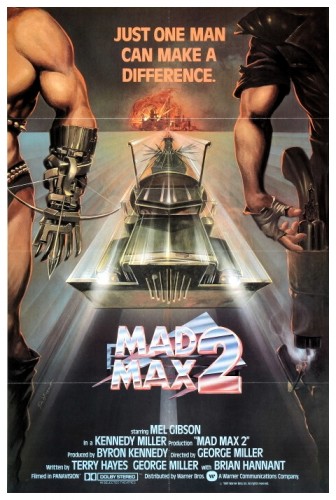 SYNOPSIS:
SYNOPSIS:
“Roaming the highways of post-apocalyptic Australia, years after he avenged his wife and son and his partner who were murdered by the motorcycle gang led by the evil Toecutter. Burnt out former Australian policeman Max Rockatansky, now known as ‘The Road Warrior’ searching for sources of fuel, stumbles upon a gasoline refinery home to a community of survivors who are struggling for survival and finds the community is being terrorized by a band of brutal motorcyclists led by The Humongous and his finest warrior, Wez, who bid to loot all the gasoline from the refinery for themselves. The community hires Max, as Max agrees to help the community transport the gasoline across the highway and fight for freedom, as they are pursued by the Humongous and his warriors.” (courtesy IMDB)
REVIEW:
If the seventies were the so-called ‘renaissance’ of Australian film-making, then surely Mad Max (1979) is our Mona Lisa. Sandy Harbutt‘s bikie culture film Stone (1974) had already ushered in a new breed of ultra-violent drive-in fare, but it wasn’t until 1979 that doctor and film buff George Miller‘s unheralded savagely anarchic ode to the road detoured the Australian film industry away from the period frocks and sexual repression of Picnic At Hanging Rock (1975), The Getting Of Wisdom (1977) and My Brilliant Career (1979), and onto more dangerous uncharted highways. Released in the USA with re-dubbed American accents, many viewers amazingly assumed that Mad Max was Italian or Spanish in origin. Mad Max II (1981) was retitled The Road Warrior for release outside Australia so as not to alienate film-goers who had not seen the original, and began shooting at Broken Hill in New South Wales where the arid terrain and endless bitumen expanses provided a convincing post-apocalyptic look.
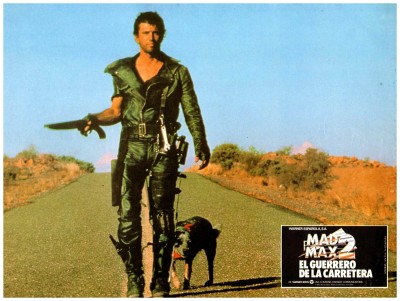 More optimistic than the first film, Miller’s exciting sequel shows how super-cop Max (Mel Gibson) regains some of the human qualities he lost when his wife and child were killed in the first film. It is an extinct countryside where a nuclear holocaust has made it tough to eke out a life (let alone a living) and only the fittest, the fastest and the fiercest survive. In this desert wasteland is a large band of gladiator-like warriors and mohawked bikers – led by a hockey-masked meat-head named Humongous (Kjell Nilsson) – lays siege to an isolated makeshift fort occupied by a ragtag community of people who still have hopes for a decent future. The warriors are after the large quantity of precious fuel that the compound-dwellers possess. Initially reluctant to get involved, Max decides to make an emotional investment in this communal group. Max offers his services: “You want to get out of here? You talk to me.”
More optimistic than the first film, Miller’s exciting sequel shows how super-cop Max (Mel Gibson) regains some of the human qualities he lost when his wife and child were killed in the first film. It is an extinct countryside where a nuclear holocaust has made it tough to eke out a life (let alone a living) and only the fittest, the fastest and the fiercest survive. In this desert wasteland is a large band of gladiator-like warriors and mohawked bikers – led by a hockey-masked meat-head named Humongous (Kjell Nilsson) – lays siege to an isolated makeshift fort occupied by a ragtag community of people who still have hopes for a decent future. The warriors are after the large quantity of precious fuel that the compound-dwellers possess. Initially reluctant to get involved, Max decides to make an emotional investment in this communal group. Max offers his services: “You want to get out of here? You talk to me.”
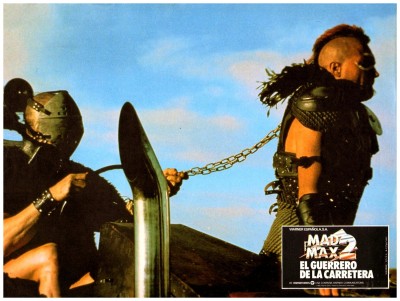 Max is a man who doesn’t go looking for Australia, because he already knows he can’t find it any more. The only thing that still counts in the wilderness is the ruthless search for fuel. In a visually stunning, amazingly photographed sequence, Max drives their oil tanker toward safety and is attacked by the marauders. He gets help from a skinny scavenger Gyro Captain (Bruce Spence) and a young mute Feral Kid (Emil Minty) with a lethal steel boomerang. There exists only a very loose connection to the first film and this sequel, so you don’t have to have seen Mad Max in order to understand The Road Warrior. Like the original, the picture contains extraordinary action sequences and stunt work. It has more horror than the original and certainly has an equal number of quirky touches and weird characters. The major difference is that the film moves out of futuristic drama into the realm of mythology, and Max becomes more of a symbol figure, a universal hero.
Max is a man who doesn’t go looking for Australia, because he already knows he can’t find it any more. The only thing that still counts in the wilderness is the ruthless search for fuel. In a visually stunning, amazingly photographed sequence, Max drives their oil tanker toward safety and is attacked by the marauders. He gets help from a skinny scavenger Gyro Captain (Bruce Spence) and a young mute Feral Kid (Emil Minty) with a lethal steel boomerang. There exists only a very loose connection to the first film and this sequel, so you don’t have to have seen Mad Max in order to understand The Road Warrior. Like the original, the picture contains extraordinary action sequences and stunt work. It has more horror than the original and certainly has an equal number of quirky touches and weird characters. The major difference is that the film moves out of futuristic drama into the realm of mythology, and Max becomes more of a symbol figure, a universal hero.
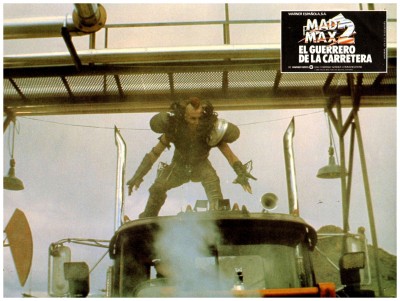 George Miller‘s direction is never really serious as he aims for a campy over-the-top approach. But his car, truck and bike stunts are stunningly choreographed, while Gibson comes across all Eastwood-like spaghetti-western-style machismo. The movie boasts a strong cartoonish feel, stripping down all the characters and situations as archetypes, then blowing them up again in an immensely flamboyant comic-book style. A gang of barbaric warriors terrorising a commune of settlers is not too far removed from the savage Indians of Hollywood’s classic westerns and, battle after battle, Max fights them off, culminating in a masterfully staged showdown chase sequence that lasts almost one-third of the movie – an orgy of gas, guns and guts. When Max has done his job, he returns to the wilderness, knowing that there can be no place for him in civilised life.
George Miller‘s direction is never really serious as he aims for a campy over-the-top approach. But his car, truck and bike stunts are stunningly choreographed, while Gibson comes across all Eastwood-like spaghetti-western-style machismo. The movie boasts a strong cartoonish feel, stripping down all the characters and situations as archetypes, then blowing them up again in an immensely flamboyant comic-book style. A gang of barbaric warriors terrorising a commune of settlers is not too far removed from the savage Indians of Hollywood’s classic westerns and, battle after battle, Max fights them off, culminating in a masterfully staged showdown chase sequence that lasts almost one-third of the movie – an orgy of gas, guns and guts. When Max has done his job, he returns to the wilderness, knowing that there can be no place for him in civilised life.
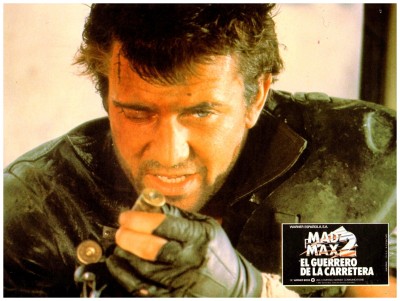 There is much in the film that is reminiscent of Sergio Leone‘s Fistful Of Dollars (1964) trilogy, A Boy And His Dog (1975), Hondo (1953) and the Alamo episode of Davy Crockett King Of The Wild Frontier (1955). Perhaps the film’s most unusual aspect is that it’s all set in the future, yet narrated by the adult Feral Kid as if it all happened in the past. While Australia was recovering from the global oil crisis of the late seventies, The Road Warrior takes up the idea of a post-industrial future ruled by petrol-syphoning warlords. Toying with the fear of running out of natural resources, the film levels criticism at our extensive car-culture on one hand, while glorifying car-fetishism through spectacular action sequences on the other hand. Max is a postmodern remodeling of Ethan Edwards (as played by John Wayne) just as The Road Warrior is a postmodern pastiche of John Ford‘s The Searchers (1956). The film’s style – a combination of comic-book violence, post-apocalyptic angst and punk-rock attitude – quickly led to its becoming a cult classic.
There is much in the film that is reminiscent of Sergio Leone‘s Fistful Of Dollars (1964) trilogy, A Boy And His Dog (1975), Hondo (1953) and the Alamo episode of Davy Crockett King Of The Wild Frontier (1955). Perhaps the film’s most unusual aspect is that it’s all set in the future, yet narrated by the adult Feral Kid as if it all happened in the past. While Australia was recovering from the global oil crisis of the late seventies, The Road Warrior takes up the idea of a post-industrial future ruled by petrol-syphoning warlords. Toying with the fear of running out of natural resources, the film levels criticism at our extensive car-culture on one hand, while glorifying car-fetishism through spectacular action sequences on the other hand. Max is a postmodern remodeling of Ethan Edwards (as played by John Wayne) just as The Road Warrior is a postmodern pastiche of John Ford‘s The Searchers (1956). The film’s style – a combination of comic-book violence, post-apocalyptic angst and punk-rock attitude – quickly led to its becoming a cult classic.
 This is no surprise considering Gibson’s superior supporting cast, some of Australia’s best acting talent. Bruce Spence (as Gyro Captain) is one of Australia’s hardest-working actors, the only actor to appear in every major film trilogy of the last two decades: Mad Max, The Matrix, The Lord Of The Rings and Star Wars. Mike Preston (as Pappagallo) was first a boxer, then a pop singer, then a television host, eventually becoming a film actor. After Mad Max II he shot to semi-stardom, playing Jared-Syn in Metalstorm The Destruction Of Jared-Syn (1983), and appearing in television series such as The A-Team, Airwolf, Alien Nation and Highlander. Virginia Hey (as Warrior Woman) became famous as Pa’u Zotoh Zhaan in the cult television series Farscape. Max Phipps (as Toadie) was the first actor in Melbourne to play Frank’n’Furter on stage in The Rocky Horror Show in the early seventies, and went on to play Prime Minister Gough Whitlam in the eighties mini-series The Dismissal. Vernon Wells (as Wez) moved to Hollywood to appear in Commando (1985), Weird Science (1985), Inner Space (1987), Circuitry Man (1990), Fortress (1992), Looney Tunes Back In Action (2003) and a lot of Mighty Morphin’ Power Rangers in between.
This is no surprise considering Gibson’s superior supporting cast, some of Australia’s best acting talent. Bruce Spence (as Gyro Captain) is one of Australia’s hardest-working actors, the only actor to appear in every major film trilogy of the last two decades: Mad Max, The Matrix, The Lord Of The Rings and Star Wars. Mike Preston (as Pappagallo) was first a boxer, then a pop singer, then a television host, eventually becoming a film actor. After Mad Max II he shot to semi-stardom, playing Jared-Syn in Metalstorm The Destruction Of Jared-Syn (1983), and appearing in television series such as The A-Team, Airwolf, Alien Nation and Highlander. Virginia Hey (as Warrior Woman) became famous as Pa’u Zotoh Zhaan in the cult television series Farscape. Max Phipps (as Toadie) was the first actor in Melbourne to play Frank’n’Furter on stage in The Rocky Horror Show in the early seventies, and went on to play Prime Minister Gough Whitlam in the eighties mini-series The Dismissal. Vernon Wells (as Wez) moved to Hollywood to appear in Commando (1985), Weird Science (1985), Inner Space (1987), Circuitry Man (1990), Fortress (1992), Looney Tunes Back In Action (2003) and a lot of Mighty Morphin’ Power Rangers in between.
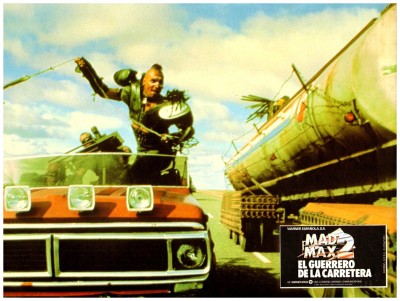 It was announced by George Miller back in 2009 that the filming of a fourth film, Fury Road, would commence at Broken Hill in New South Wales in late 2010, ending years of speculation. This announcement attracted widespread media attention, with the popular speculation on whether Mel Gibson would return as Max, even though this had previously been considered unlikely. It was also announced that both British actor Tom Hardy and American actor Karl Urban were being considered for the lead role of Max, and Charlize Theron will also play a lead role. The plot will be set shortly after the events of Mad Max III Beyond Thunderdome (1985). Now, January 2014, we’re still waiting. And it’s on that sour note I’ll bid you a good night and look forward to your company next week when I have the opportunity to put goose-bumps on your goose-bumps with more ambient atmosphere so thick and chumpy you could carve it with a chainsaw, in yet another pants-filling fright-night for…Horror News! Toodles!
It was announced by George Miller back in 2009 that the filming of a fourth film, Fury Road, would commence at Broken Hill in New South Wales in late 2010, ending years of speculation. This announcement attracted widespread media attention, with the popular speculation on whether Mel Gibson would return as Max, even though this had previously been considered unlikely. It was also announced that both British actor Tom Hardy and American actor Karl Urban were being considered for the lead role of Max, and Charlize Theron will also play a lead role. The plot will be set shortly after the events of Mad Max III Beyond Thunderdome (1985). Now, January 2014, we’re still waiting. And it’s on that sour note I’ll bid you a good night and look forward to your company next week when I have the opportunity to put goose-bumps on your goose-bumps with more ambient atmosphere so thick and chumpy you could carve it with a chainsaw, in yet another pants-filling fright-night for…Horror News! Toodles!
 Horror News | HNN Official Site | Horror Movies,Trailers, Reviews
Horror News | HNN Official Site | Horror Movies,Trailers, Reviews
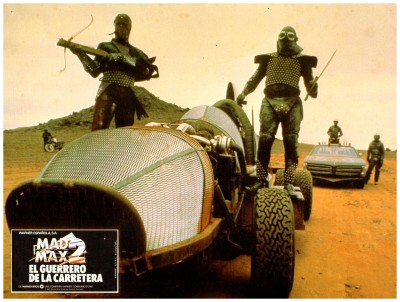
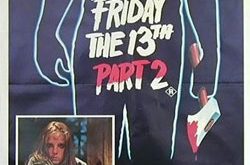
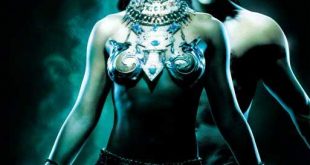
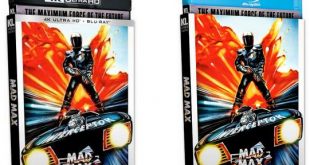
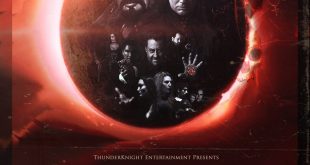
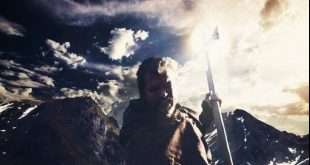
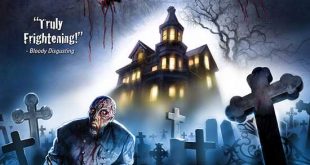
Good review. I’d forget how good the costumes and scenes looked.